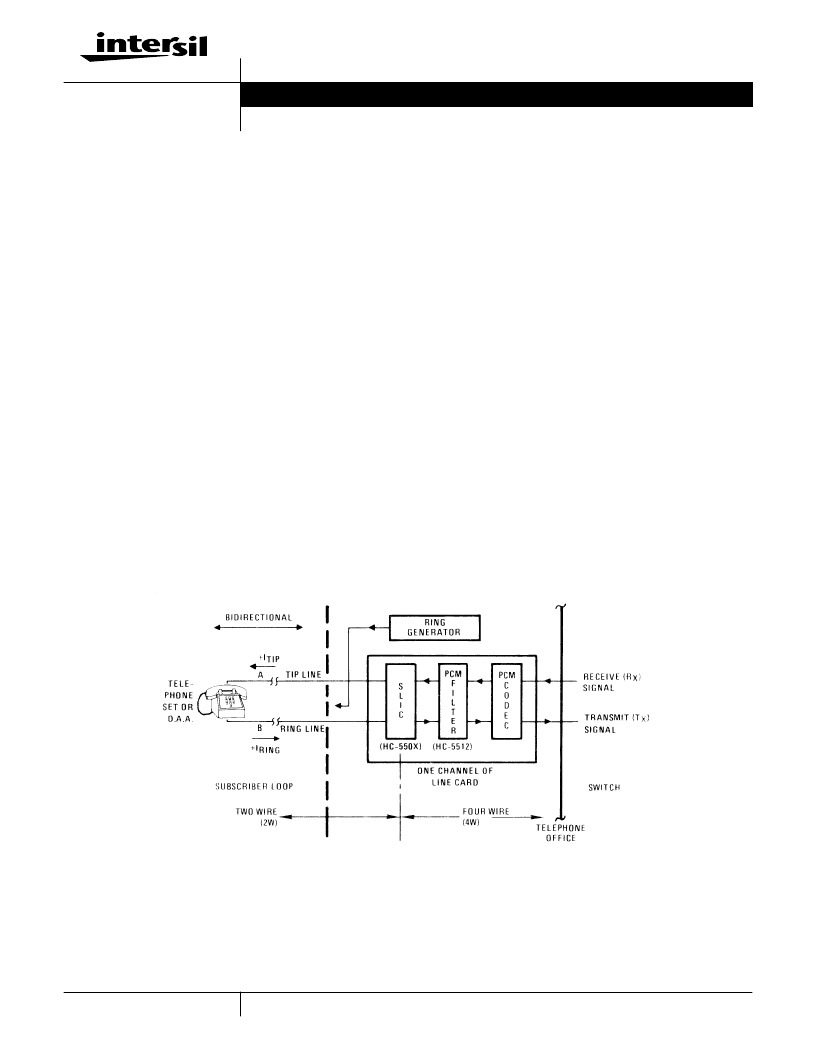- 您現在的位置:買賣IC網 > PDF目錄385353 > HC-5502X (Intersil Corporation) () PDF資料下載
參數資料
| 型號: | HC-5502X |
| 廠商: | Intersil Corporation |
| 英文描述: | () |
| 中文描述: | () |
| 文件頁數: | 1/17頁 |
| 文件大小: | 255K |
| 代理商: | HC-5502X |

4-1
TM
AN549.1
1-888-INTERSIL or 321-724-7143
|
Intersil and Design is a trademark of Intersil Corporation.
|
Copyright
Intersil Corporation 2000
The HC-5502X/4X Telephone Subscriber Line
Interface Circuits (SLIC)
Introduction
The HC-5502X/4X family of telephone subscriber line
interface circuits (SLIC) integrate most of the BORSCHT
functions of the traditional hybrid transformer interface circuits
onto one chip. The circuits are manufactured in a 200V
dielectric isolation (DI) process and together with a secondary
protection diode bridge give 1kV of isolation from lightning
induced faults between the subscriber loop and the telephone
office.
The BORSCHT functions provided are:
Battery Feed With Loop Current Limiting
Overvoltage Protection
Ringing
Supervision/Signalling
Hybrid
The HC-5502X is intended for use in systems utilizing single
ended tip (positive side) injected ringing and limits the short
loop current to 30mA; the HC-5504X is intended for use in
ring side (negative side) injected ringing systems and will limit
the short loop current to 40mA. It should be noted that the
HC-5504X can also be configured to operate in switches
employing either of the two single ended ringing methods and
in balanced ringing systems.
This note will describe each subfunction of the SLIC and will
discuss several system design features, including balance
networks and complex impedance matching.
An Overview of the Basic Phone Loop
And Its Environment
Figure 1 illustrates a simplified telephone network. Each
subscriber is connected via a 2-wire (2W) loop to a switch
office which provides intersubsciber loop switching and
signal processing (analog and/or digital).
The SLIC is the primary interface between the 4 wire (4W)
(ground referenced) low voltage switch environment and the
2W (“floating”) high voltage loop environment.
The loop consists of a wire A (the Tip wire), the telephone
set or its equivalent, and wire B (the ring wire). A DC voltage
is applied across the Tip and Ring wires at the line card
which is housed in the telephone office: The battery is
usually a nominal -48V, and is often called the quiet or
talking battery. When the telephone is off-hook, a DC path is
established around the loop. DC loop current will flow around
the loop from tip feed to ring feed. This is called Battery
Feed.
FIGURE 1. SIMPLIFIED TELEPHONE NETWORK
Application Note
January 1997
Author: Geoff Phillips
相關PDF資料 |
PDF描述 |
|---|---|
| HC-5509A1 | SLIC Subscriber Line Interface Circuit |
| HC4P5509A1-9 | SLIC Subscriber Line Interface Circuit |
| HC4P5509A1-5 | SLIC Subscriber Line Interface Circuit |
| HC1-5509A1-5 | SLIC Subscriber Line Interface Circuit |
| HC3-5509A1-5 | SLIC Subscriber Line Interface Circuit |
相關代理商/技術參數 |
參數描述 |
|---|---|
| HC5503 | 制造商:INTERSIL 制造商全稱:Intersil Corporation 功能描述:Low Cost 24V SLIC For PABX / Key Systems |
| HC5503C | 制造商:INTERSIL 制造商全稱:Intersil Corporation 功能描述:Unbalanced PBX/Key System SLIC, Subscriber Line Interface Circuit |
| HC5503CB | 制造商:Rochester Electronics LLC 功能描述: 制造商:Intersil Corporation 功能描述: |
| HC5503CB96 | 制造商:Rochester Electronics LLC 功能描述:HC5503CB (TAPE&REEL) - Bulk |
| HC5503CBZ | 功能描述:電信線路管理 IC LW COST ISDN SLIC 24S0 RoHS:否 制造商:STMicroelectronics 產品:PHY 接口類型:UART 電源電壓-最大:18 V 電源電壓-最小:8 V 電源電流:30 mA 最大工作溫度:+ 85 C 最小工作溫度:- 40 C 安裝風格:SMD/SMT 封裝 / 箱體:VFQFPN-48 封裝:Tray |
發布緊急采購,3分鐘左右您將得到回復。